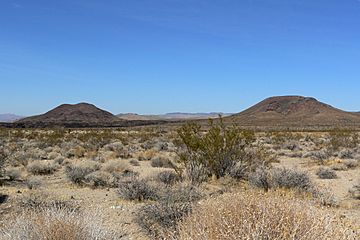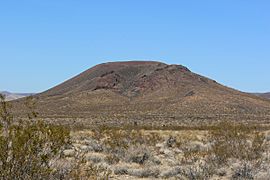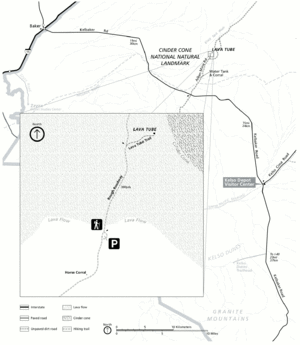Cima volcanic field facts for kids
Quick facts for kids Cima volcanic field |
|
|---|---|

Cinder cones seen from Kelbaker Road.
|
|
| Highest point | |
| Geography | |
| Geology | |
| Age of rock | Late Miocene-Pleistocene ~13-0.015 Ma |
| Mountain type | Volcanic field |
| Last eruption | 15,000 ± 5,000 years before present |
The Cima volcanic field is a special area in San Bernardino County, California. It's very close to the border with Nevada. This area is like a big outdoor museum of volcanoes!
It covers about 600 square kilometres (230 sq mi) (that's about 230 square miles) inside the Mojave National Preserve. Here, you can find around 40 different volcanic cones and about 60 lava flows. Some cones are simple hills, while others have many craters or are worn down by time. The lava flows can be super long, up to 9.1 kilometres (5.7 mi) (about 5.6 miles)! There's even a cool lava tube you can visit.
Volcanoes here started erupting a very long time ago, about 13 million years ago. They took a break for a few million years, then started again. The youngest volcano, called the Black Tank cone, formed about 15,000 years ago. It might have even erupted more than once!
Contents
Where is the Cima Volcanic Field?
The Cima volcanic field is located in the eastern part of the Mojave Desert in California. It sits between the Shadow Valley to the northeast and the Soda Lake Valley to the southwest.
You can find Kelbaker Road southwest of the field, which actually crosses some of the old lava flows. There are also dirt roads like the Indian Springs Trail and Aiken Mine Road that wind through the volcanoes.
Interstate 15 passes north of the field. The city of Las Vegas is about 120 kilometres (75 mi) (75 miles) northeast of this volcanic area. The Cima volcanoes are part of the Mojave National Preserve. Since 1973, they have been a special place called the Cinder Cones National Natural Landmark.
Long ago, people carved petroglyphs (rock art) into the lava flows here. One of the cinder cones was even used as a quarry to get materials for building roads. Scientists also study the soils and how the landscape developed in this volcanic field.
Volcanoes in the Western United States
Volcanoes are common in the western United States. They come in many shapes and sizes. For example, the Cascade Range volcanoes, like Mount St. Helens, were formed when one Earth plate slid under another. Other famous volcanic areas include Yellowstone Caldera and the Snake River Plain.
The Cima volcanic field is part of a larger group of volcanoes in the western Basin and Range Province. This region has many dry areas where volcanoes have erupted over millions of years. First, there was a type of volcanism that created lighter-colored rocks. Later, during more recent times, volcanoes mostly erupted basaltic (darker) lava. These eruptions often came from short-lived vents.
Other examples of this kind of volcanism include the San Francisco volcanic field in Arizona and the Zuni-Bandera volcanic field in New Mexico.
The Mojave Desert, where Cima is located, is part of the Basin and Range Province. This area has mountains over 2,000 metres (6,600 ft) (6,500 feet) tall, which run in a southeast-northwest direction. Wide valleys lie between these mountains.
What the Cima Volcanoes Look Like
There are about 40 volcanic cones in the Cima volcanic field. These cones can be as wide as 890 metres (2,920 ft) (about half a mile) and as tall as 170 metres (560 ft) (about 550 feet). They are mostly found on a slope that tilts towards the south-southwest.
Some cones look almost new, with their craters still perfectly shaped. Others have been worn down by wind and water over time, looking more like hills. Some even have more than one crater!
The youngest cone, called Black Tank cone, is in the southwestern part of the field. It created a 2-kilometre (1.2 mi) (1.2-mile) long lava flow. This flow first moved through a channel, then spread out into a wider, rounded shape. It also has signs of a lava tube inside it.
The field has black and red volcanic rocks. You can see cinders, which are small, bubbly pieces of lava. There are also lava bombs, which are larger chunks of lava thrown out during an eruption. Some cones are covered in these bombs and cinders. In some places, tuff rings formed when magma mixed with water, causing explosive eruptions.
Over time, Erosion has carved gullies and even a 150-metre (490 ft) (500-foot) deep gorge into the older cones.
The volcanic material covers about 150 square kilometres (58 sq mi) (58 square miles) within the larger 600 square kilometres (230 sq mi) (230 square miles) field. The volcanoes sit on top of older rocks, including crystalline bedrock and thick gravel.
Lava Flows
The cones in the Cima field have produced about 60 lava flows. These flows can be up to 9.1 kilometres (5.7 mi) (5.6 miles) long and 2.5–4 metres (8 ft 2 in – 13 ft 1 in) (8-13 feet) thick. Their surfaces can look smooth and ropy, like pahoehoe lava, or rough and blocky, like aa lava. This depends on how steep the ground was when they flowed.
The lava flows have cool features like levees (natural walls along the edges), finger-like shapes, and even pieces of the cones that floated away on the lava. You can see long, gently sloping flows and shorter, steeper, rougher flows covered with large blocks of rock.
One major lava tube in the Cima field is open to visitors! You can get into it through a skylight (a hole in the roof). It's about 100 metres (330 ft) (330 feet) long and 5–3 metres (16.4–9.8 ft) (16-10 feet) wide. In some spots, the lava flowed around older rock outcrops, leaving behind "islands" of older land called kipukas. Most of the lava flowed westward because of the slope of the land.
Newer lava flows still have clear features on their surface. But older flows are often covered by younger material and have lost their original look. The very oldest flows are flat or gently sloped, and their source volcanoes are very worn down. Wind and erosion have also covered some lava flows with dust and a dark coating called desert varnish.
What the Rocks are Made Of
The volcanoes in this field have erupted types of lava called alkali basalt, basanite, and hawaiite. These rocks contain visible crystals of minerals like clinopyroxene, olivine, and plagioclase.
Sometimes, you can find pieces of other rocks, called xenoliths, inside the lava. These can include rocks like dunite, gabbro, and granite. These xenoliths tell scientists about the rocks deep inside the Earth. The type of rock erupted by the Cima volcanoes hasn't changed much over time. Scientists think the lava from the Black Tank cone was about 1,110 °C (2,030 °F) (2030°F) hot when it erupted!
The melted rock (magma) that erupted here seems to have come from deep within the Earth's mantle. It didn't mix much with the Earth's crust. Scientists believe that hot material rising from the mantle caused these volcanoes. This might be linked to how the Earth's plates changed their movement in this region.
Climate and Plants
The Cima area has a warm and dry climate. The average temperature is about 18–16 °C (64–61 °F) (64-61°F). It doesn't rain much, only about 250–150 millimetres per year (9.8–5.9 in/year) (10-6 inches) of rain each year. Most of the rain falls in winter, with only a little bit during the summer monsoons.
Before about 10,000 years ago, the climate was wetter. This helped soils form on the lava flows. During more recent times, dry lakebeds (called playas) became sources of wind-blown dust that settled on the lava.
The plants in this area are mostly scrub plants. You can find plants like brittle bush, creosote bush, Mormon tea, and white bursage. At higher elevations, you can see Joshua trees. Some of these plants arrived recently, while others have been here for a very long time.
The plants often grow in groups, with bare soil covered by desert pavement (a surface of tightly packed rocks) in between. The youngest volcano, the Black Tank cone, has almost no plants growing on it. Other recent lava flows also have very little plant life.
When Did the Volcanoes Erupt?
Scientists have studied the ages of the Cima volcanoes using different methods. Early studies thought the northern part of the field was older and the southern part was younger. Later, more accurate dating showed that the northern volcanoes are indeed older (Miocene age), and the southern ones are younger (Pleistocene age).
Scientists estimate that there have been about 8 eruptions every 100,000 years in the Cima field.
Using a method called potassium-argon dating, scientists found that volcanic activity started about 13 million years ago and continued until about 10,000 years ago. They've divided the activity into five main periods:
- The first was between 7.6 and 6.5 million years ago.
- The second was between 5.1 and 3.6 million years ago.
- The third was between 1.1 and 0.6 million years ago.
- The fourth was between 750,000 and 200,000 years ago.
- The fifth and last was between 200,000 and 10,000 years ago.
There was a quiet period for about 2 million years, between 3 and 1 million years ago, when no eruptions happened.
The oldest eruptions left a very worn-down volcano in the southeastern part of the field. Later eruptions created lava flows in the northern part, which now look like eroded flat-topped hills (called mesas). The last three periods of eruptions formed the lava flows and volcanoes in the southern part of the field.
Eruptions often started with explosive events that created maars (wide, low-rimmed craters). Then, cinder cones grew, and lava flows spread out. Unlike most cinder cones, which usually erupt only once, some cones at Cima erupted multiple times over hundreds of thousands of years!
The Black Tank cone, the youngest volcano, is about 15,000 years old. Some evidence suggests that its lava flow might have formed during two separate eruptions. The lava flow itself probably formed in less than a week! Wind also played a role, carrying volcanic ash (called tephra) to the east-southeast, where it formed a blanket over the land.
Images for kids







